Seahorses, either real or mythical, have always been objects of human fascination for centuries. With their horse-shaped head, eyes as tiny as glass fishbowls, kangaroo-like pouches, chiffon frills-like fins and monkey-like tails, seahorses have always intrigued and enchanted human since ancient times. What’s even more fascinating is because the male seahorses are the one who give birth to their offspring.
Mythically, in Roman legend when they pulled Neptune’s chariot and consorted with mermaids. However, on the more earthly side, they were associated with medical world as they were listed by Pliny the Elder as the major ingredient to cure baldness. They have also always been equated with medicinal efficacy as a restorer of strength and enhancer of potency. (read: Deep Ocean Ecosystems)
Habitat
Seahorses live in both tropical and temperate waters, though their greatest number of species can be found in the Indo-Pacific region. Their typical habitats are sea-grass, seaweed, mangroves, and coral reefs. They usually live from the shallows to the depths of over 100 meters. Most seahorses are strictly marine creatures, but a few of their species can tolerate estuarine conditions.
Sizes of Seahorses
The size of seahorses’ vary from Hippocampus ingens of the American continent (a valid draft-horse that measures up to 40 cm from the coronet to the tip of the tail), to the Shetland pony of seahorses, southeastern Australia’s H. minotaur that measure around 1.5 cm in length. Zoologists classify seahorses in the Syngnathidae family of bony fishes that includes pipe-fishes, pipe-horses and sea-dragons. They are named as Hippo-campus which was taken from the Greek words of horse and sea monster.
However, unfortunately this fascinating sea creature is now in danger of their lives. Like any other sea creature, the future of seahorses is now in question as threats such as pollution, habitat loss and accidental fishing increasingly reduce their populations. However, the biggest threat seahorses face come from the unsustainable harvesting of these creatures from their habitats. (see also: Salinity of Ocean Water)
Consumption by Human
In 1995, total global consumption was estimated to be around 56 tonnes or 20 million individuals. Seahorses are destined not for dinner plate (though stir-fried seahorse is not unknown in Oriental cuisine). They are grounded up for use in traditional medicines. It is said that every year, around 20 million seahorses are harvested live from the world’s oceans to be traded for traditional Chinese medicine.
In traditional Chinese medicine and its derivatives, the seahorse is credited with increasing energy flows within the body and decreasing cholesterol levels. It is also said seahorses have a curative role in such diverse ailments as asthma, impotence, goitre, kidney disorders, and skin afflictions such as severe acne and persistent skin nodules. In traditional Chinese medicine, seahorses are also sold as whole, bleached, and dried animals, as a powder, ot in patented pill form. They are usually combined with a range of other animal and plant ingredients depending on the condition of the person being treated. (Read: Surface of Tension Liquids)
Many seahorses are also captured alive for home aquariums. Hundreds of thousands of seahorses are sold for the aquarium trade driven primarily by North Americans. Most of these seahorses are juveniles where they usually die within a short period. They are extremely difficult to maintain in good condition over long periods because of the relatively large amounts of live food that they require as well as their susceptibility to various diseases.
On top of being used for home aquariums, seahorses face risks from direct human action such as fishing equipments. They are often caught in the shrimp trawl and other fisheries off of Florida, Central America, Mexico, and South America. They also have relatively low birth rates and exist in small populations pockets, and face threats through habitat alteration. (read: Sea Erosion)
Changes in water conditions also jeopardize the health of a lot of sea creatures including seahorses because marine habitats are very sensitive. Seahorses face loss of habitat from many human activities and even suffer from onshore activities like deforestation. Pollutants leaching into marine environments pose a risk to seahorses. The same risks come from fishing and other marine activities.
see also:
It is unfortunate that seahorses around the world might have a hard ride ahead of them. Just like corals and other marine animals, millions of seahorses are collected alive and dried as souvenirs and utilized as curious with a high availability in beach resorts and shell shops around the world with the greatest number of the harvested seahorses are imported to Asia.
Another unfortunate thing for seahorse is a combination of public awareness and aqua-cultural research-some of it being conducted in a lot of countries may turn the tide for these fascinating sea creatures. A charity called Save Our Seahorses (SOS) even carried out an undercover research which shows more than 150 million seahorses are actually killed annually. Seashore fisheries have also reporter that there is a minimum decline of seashores around 50 percent in the last five years. SOS concludes that it means seashores could become extinct within the next 30 years.
The Endangered Seahorse Species
There are several endangered seahorse species, as follows:
1. Hippocampus Capensis
 Of all seahorses species, the most endangered one is the Cape seashore (Hippocampus capensis) endemic to South Africa. Hippo-campus capensis or usually called The Knysna seahorse is the only seahorse species known to exclusively inhabit estuaries.
Of all seahorses species, the most endangered one is the Cape seashore (Hippocampus capensis) endemic to South Africa. Hippo-campus capensis or usually called The Knysna seahorse is the only seahorse species known to exclusively inhabit estuaries.
The Knysna seahorse is a medium-sized seahorse (8-12 cm) with a characteristic short snout and the males have a slight keel above their brood pouch. Their colors are vary from white, yellow orange, green, beige, to brown and black. Though there are a lot of different colors, The Knysna are typically mottled brown.
They have the smallest geographical range of all seahorses species. They can be found in 3 estuaries, Knysna, Swartvlei, and Keurbooms. The Knysna are the first seahorse species to be classified by the IUCN as endangered species. All over the world, seahorse populations are threatened by the degradation of estuaries, sea-grass beds, and mangroves. Knysna seahorses are also often accidentally captured in fishing gear, over exploited for use in traditional medicines, and the aquarium trade. They are also vulnerable to large temperature fluctuations that are common in the area where they can be found. (see also: How to Prevent El Nino)
2. Hippocampus Algiricus
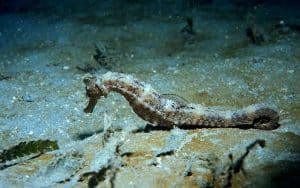 Other than The Knysna, there is also another species of seahorse called Hippocampus Algiricus (West African seahorse), the only seahorse species found off the coast of West Africa.
Other than The Knysna, there is also another species of seahorse called Hippocampus Algiricus (West African seahorse), the only seahorse species found off the coast of West Africa.
The Convention on International Trade in Endangered Species (also known as CITES, the United Nation body tasked with ensuring sustainability in the global wildlife trade) recently announced the suspension of all exports of these threatened West African seahorses from Senegal and Guinea.
See also: Sea Salt Facts
While The Knysna have been categorized as endangered, West African seahorses are threatened and they are poorly evaluated (data deficient). There are no known research on West African seahorses’ biology, ecology, fisheries, trade, or conservation status. Even their distribution and habitat use is largely undocumented. This is also why West African seahorses’ population trends and status are very difficult to detect. (Read: oceans in the world)
3. Hippocampus Abdominalis
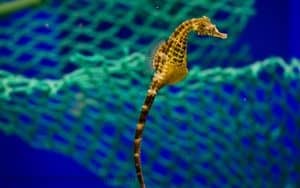 Hippocampus Abdominalis, also usually called big-belly seahorse is one of the largest seahorses. As the common name suggests, this seahorses species has a large swollen belly. They have dark spots and blotches on the head and truck. Their tails often have alternating pale and dark bands and the males have longer tails than the females.
Hippocampus Abdominalis, also usually called big-belly seahorse is one of the largest seahorses. As the common name suggests, this seahorses species has a large swollen belly. They have dark spots and blotches on the head and truck. Their tails often have alternating pale and dark bands and the males have longer tails than the females.
Big-belly seahorses usually live in coastal bays and can be found amongs algae, sea-grasses, and around rocky reeds in fairly shallow water. In deeper water they usually attach to sponges.
This species of seahorse is found in south-west Pacific around Australia and New Zealand, specifically in Newcastle, New South Wales Southwards, Victoria, Tasmania, North and South Islands.
This species of seahorse is on the verge of endangered too since they have to face some main global threats such as habitat loss, incidental by-catch in commercial fisheries, and over-exploitation. Big-belly seahorses are also widely caught to be kept as a pet. For oriental medicine trade, they are dried and used as an ingredient in tonic and as an aphrodisiac. (see also: Ocean Coral Reef)
4. Hippocampus Guttulatus
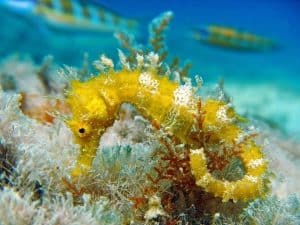 Hippocampus Guttulatus or the maned seahorse is one of the most striking species of seahorse. They are called ‘maned’ because of the prominent fleshy spines that run down the back of their neck.
Hippocampus Guttulatus or the maned seahorse is one of the most striking species of seahorse. They are called ‘maned’ because of the prominent fleshy spines that run down the back of their neck.
Although their physical color mimic the color of the surrounding environment, they are mostly green-yellow to reddish brown colored. Maned sea-houses inhabit shallow waters down to a depth of 12 meters, in areas of seaweed or sea grass. However, when winter comes they usually move and live in deeper waters. (See also: Marine Disasters)
Maned seahorses are included as a threatened species too since they are caught intentionally or accidentally in Portugal where they are usually dried and sold for curious.
This species of seahorse also known to be captured incidentally in Italy, France, Spain, and Croatia. They are also exploited to be kept in aquariums or pet trade. Since Maned seahorses live in shallow coastal habitats, they are even more vulnerable since those particular areas susceptible to the negative impacts of human activities.
5. Hippocampus Histrix
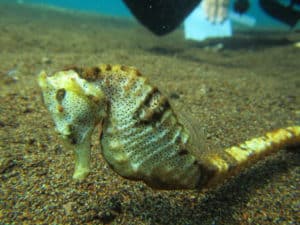 Hippocampus histrix or usually called as the spiny seahorse because of the project from the corners of their bony plates that cover the body, is also one of the most intriguing and peculiar looking seahorses. They can be distinguished by their very long snout which is sparsely patterned with white bars. (See also: Climate of the Ocean)
Hippocampus histrix or usually called as the spiny seahorse because of the project from the corners of their bony plates that cover the body, is also one of the most intriguing and peculiar looking seahorses. They can be distinguished by their very long snout which is sparsely patterned with white bars. (See also: Climate of the Ocean)
They have independently-moving eyes that enable them to scan their surroundings for potential prey. With a rapid intake of water, spiny seahorses suck their prey up into their long snout. They usually live in the depth of at least six meters among soft coral, sponges and sea squirts where there is little or no sea-grass.
They can also be found in shallower areas where algae grow on reef rubble. Just like most threatened seahorses species, spiny seahorses are also threatened by exploitation for use in traditional Chinese medicines as well as for curious, aquariums, and souvenirs. They are just as threatened even if they are somehow less desirable than some other species for the traditional Chinese medicine trade and also are rarely seen in the aquarium trade.
see also:
6. Hippocampus Kuda
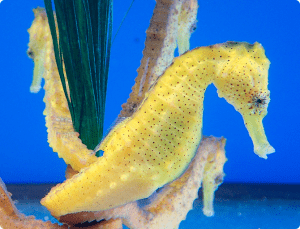 Hippocampus Kuda or the common seahorse is a large species of seahorse. Just like any other seahorses, common seahorses are held at right angles to their body, their eyes can move independently, and their tails are prehensile. (See also: Ocean Layers)
Hippocampus Kuda or the common seahorse is a large species of seahorse. Just like any other seahorses, common seahorses are held at right angles to their body, their eyes can move independently, and their tails are prehensile. (See also: Ocean Layers)
Common seahorses have a deep head and body and a thick robust snout. They are also the master of camouflage and may occasionally be sandy in color so they can blend with the background.
Like other seahorses, this species is an ambush predator and lies in wait for small crustaceans to swim by before sucking them into their mouth.
Common seahorses can be found throughout Southeast Asia, Australia, Japan, and some Pacific islands like Hawaii. Unfortunately, even if they are a relatively large seahorse species they are not that common to be found anymore. Surveys show that their populations have declined and fishers are also reporting massive decreases. Common seahorses are sold locally and internationally for traditional medicines, they are even one of the most valuable seahorses in traditional Chinese medicine. They are also very popular as an aquarium pet.
7. Hippocampus Bargibanti
 Hippocampus bargibanti or the pygmy seahorse is one of the most well camouflaged seahorse species as they are very difficult to spot amongst the gorgonian coral they live in.
Hippocampus bargibanti or the pygmy seahorse is one of the most well camouflaged seahorse species as they are very difficult to spot amongst the gorgonian coral they live in.
They are also very unique with their large bulbous tubercles covered body that match the color of the polyps of its host species of gorgonian coral. (See also: Global Warming in Ocean)
They are also one of the smallest seahorse species in the world, measuring less than two centimeters in height. They mostly live in the depth of 16 until 40 metres. (see also: Ocean Plants)
Pygmy seahorses can be found in the tropical western Pacific around Queensland, Indonesia, Japan, New Caledonia, Papua New Guinea and the Philippines. They also face major threats like exploitation even though it is very little known about the total number of their population trends and distribution. Since they have unusual and attractive colouration, it is most likely that they could be collected for the aquarium trade.
8. Hippocampus Spinosissimus
 Hippocampus spinosissimus or the hedgehog seahorse is also an unusual and intriguing looking seahorse with its spiny appearance. Unlike most, their body lacks scales and their skins are stretched over a series of bony plates that appear as rings around their trunk and tail.
Hippocampus spinosissimus or the hedgehog seahorse is also an unusual and intriguing looking seahorse with its spiny appearance. Unlike most, their body lacks scales and their skins are stretched over a series of bony plates that appear as rings around their trunk and tail.
Hedgehog seahorses have a variety of colors, often plain or pale with darker markings across the back and dark cross-bands on the tail. Hedgehog seahorses live on coral reefs or on muddy or sandy bottoms near reefs at a depth of up to 70 metres.
Hedgehog seahorses usually can be found in the Indian Ocean and western Pacific Ocean. They also have been recorded around Australia, China, India, Sri Lanka, and Southeast Asia. They are also under threat from both targeted and incidental catch, as well as from habitat degradation. Though reportedly they are less desirable for tradition chinese medicine, their use may be increasing with the rise of chinese herbal patent medicines. So far, hedgehog seahorses declines have been reported in the Philippines and Indonesia.
9. Hippocampus Erectus
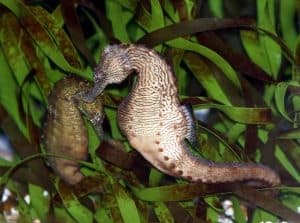 Hippocampus erectus or the lined seahorse has a mostly similar appearance with other seahorse species. Their colors are usually quite variable from ash-grey, orange, brown, yellow, and red to black.
Hippocampus erectus or the lined seahorse has a mostly similar appearance with other seahorse species. Their colors are usually quite variable from ash-grey, orange, brown, yellow, and red to black.
They have a characteristic pattern of pearly white lines that follow the contour of their neck and that is why they are named as lined seahorse.
They usually live from the surface and bottom waters of both shallow and deep areas of channels, bays, salt marshes, and near-shore coastal waters up to 73 meters. (See also: Marine Energy)
Lined seahorses can be found in the Western Atlantic, specifically from the southern tip of Nova Scotia in Canada along the east coast of the USA to the south up until the Gulf of Mexico, the Caribbean and Venezuela. They are also threatened by targeted catch and incidental capture by fisheries. There is also a huge demand for lined seahorses to be sold to the aquarium trade and also for traditional chinese medicine. They are also particularly popular as an aquarium fish in North America with thousands collected every year in Florida alone. They are also popular in Brazil and Mexico.
10. Hippocampus Comes
 Hippocampus comes or usually called as tiger tail seahorse because of its black and yellow striped tail, is also one of the most unique seahorse species. Just like others, they can camouflage and even grow skin filaments over time to better blend in with the surroundings.
Hippocampus comes or usually called as tiger tail seahorse because of its black and yellow striped tail, is also one of the most unique seahorse species. Just like others, they can camouflage and even grow skin filaments over time to better blend in with the surroundings.
Tiger tail seahorses have a variable colours ranging from yellow to black and brown and there are mottled patterns on their body with fine white lines radiating from the eyes. They inhabit coral reefs, sponge gardens, seagrass bed at the depth of up to 20 metres.
Tiger tail seahorses can be found in the eastern Indian Ocean, western central Pacific Ocean, Philippines, Indonesia, Malaysia, Singapore, Vietnam, Thailand. They are threatened by illegal captures to be used in traditional chinese medicine, as a curio, or for aquarium trade. Their shallow habitats are often highly affected by human activities too so they also face habitat degradation. (see also: Types of Sea Urchins)
Take Actions in Saving Endangered Seahorses
Seahorses are an important part of the marine world and saving them is an imperative. They can serve as flagship species for a wide range of marine conservation issues. A lot of government officials and experts have taken actions in trying to save the seahorses. Project Seahorse, global experts on seahorse conservation, will undertake short-term research in West Africa to expand the world’s knowledge of specifically West African seahorses species and its exploitation. (see also: Effects of Sea Level Rise)
The project has a long and accomplished history of ecological and trade study as well as being responsible for most field and trade research on seahorses. The project will form the basis for in-country joint initiatives for seahorse conservation. Project Seahorse’s findings will also be disseminated in reports to governments and other collaborators to improve export management and will also be published as a primary/refereed publication.
CITES also urges countries to join in their mission in saving the Endangered Seahorses. A total of 175 nations have agreed that seahorse exports need to be limited to sustainable levels if wild populations of these fishes are to persist. A great deal of information is needed for such controls to be implemented in a meaningful way. Such support is particularly important as seahorses are among the first marine fishes of commercial value to be brought under these international controls. (See also: Ocean Natural Resources)
Since 2004, indeed seahorses has been listed as threatened species under Appendix II by CITES. This has probably been helpful by requiring member nations to ensure that their exports of these species are sustainable. But there is a much greater power to stop this and it lies in the hands of the consumers. Consumers are very influential because they can stop supporting industries that are detrimentally affecting these seahorses. It is important to make educated decisions when purchasing products such as seafood as certain fishing methods destroy habitats and scoop up seahorses along with other organisms, such as shrimp trawlers. (See also: Ocean Phenomena)
- Stop Purchasing Seahorses Products
It is also important to stop purchasing souvenirs or other products made with Endangered Seahorses. Don’t buy dead seahorses, it is okay picking up already dead seahorses from the beach. But don’t buy the ones on sale in seaside souvenir shops since they were most likely grabbed live from the sea.
People should also stop buying seahorse medicines since every year at least 25 million seahorses are taken from the sea and since a driving force behind the seahorse trade is actually demand for chinese medicines. Especially to anyone who isn’t familiar with the widespread practice of using seahorses as traditional medicines. It is especially worrying with the growing popularity of pre-packaged, off-the-shelf seahorse medicines. So please think about engaging your compassion for the natural world and pick alternative medicines that don’t include these endangered species. (See also: Ocean environment)
- Prevent Seahorses become Pet
People shouldn’t be keeping seahorses as pets either, because they’re quite difficult to understand and be kept for a long time. Let them stay in their original habitat and what we can do is lessening our activities that could negatively affect their original habitat. (See also: Marine Protected Areas)
- Reduce Carbon Emissions
Human release carbon dioxide into the atmosphere, but a lot of it ends up absorbed by the oceans when the ocean itself is already wrecked by a particular marine catastrophe. The oceans end up becoming more acidic and the Endangered Seahorses along with other marine creatures will get hit hard because it affects their habitats. Their habitats include coral reefs, seagrass meadows, mangroves, and estuaries, they could be affected by pollution, climate change, and other habitat destructions. What we can do is to reduce carbon emissions to the air. We can help by doing simple things like switching off lights and turning down thermostats. We can also wear seater, insulate our house, recycle things, drive and fly less, ride our bike more or just take a walk if you’re going somewhere. Overall, we should just take actions against climate change.
see also:
We should take action over the creation of marine reserves or places where destructive influence of humankind is minimized. Currently, only less than one percent of the oceans are offered protection from human activities. This needs to be improved. Individuals may not have the power to set up marine reserves, but what’s vital is public support from locals, regional, national, and international campaigns to protect the oceans.
People should also take a trip to where they can see seahorses in their habitats at least once. It is important to witness and take a lot of how amazing these creatures are and the wild world they live in. This will motivate people more in caring and joining projects to save seahorses. Maybe people can go dive or support dive operations that care about their local seahorses. (See also: Waves in Ocean)
The fate of Endangered Seahorses and other marine creatures may seem insignificant for some people but these creatures are actually important in our life. They are not the only ones affected by human exploitations, the declining numbers of these creatures represents threats to the marine ecosystems and the health of our oceans. Therefore, it is important for us to take actions in saving the oceans and the creatures living there. (See also: Ocean Pollution)